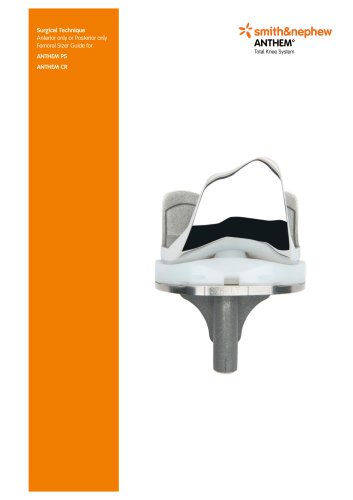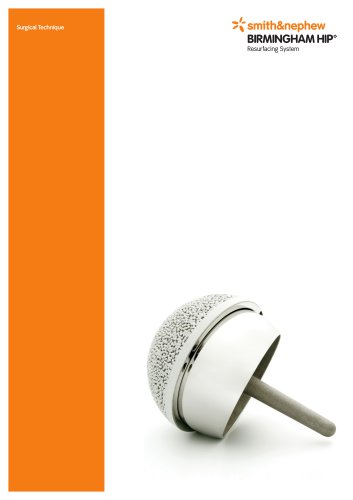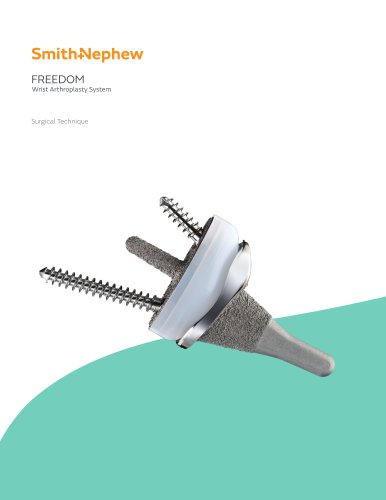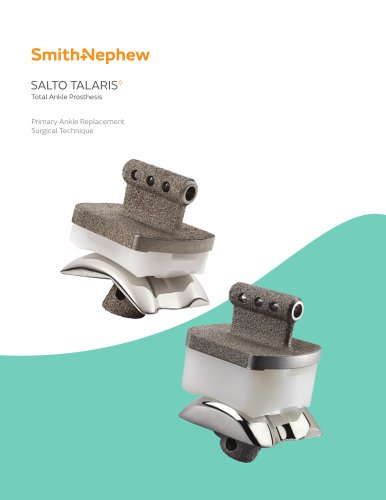
Catalog excerpts

Surgical Technique Locking Large Fragment Overview
Open the catalog to page 1
PERI-LOC™ Locked Plating System Locking Large Fragment Overview Surgical Technique Nota Bene The technique description herein is made available to the healthcare professional to illustrate the treatment for the uncomplicated procedure. In the final analysis, the preferred treatment is the individual surgeon’s decision, which addresses the needs of the specific patient.
Open the catalog to page 3
Product overview Introduction The PERI-LOC™ Periarticular Locked Plating System from Smith & Nephew offers the advantages of locked plating with the flexibility and benefits of traditional plating in one system. Offering both locking and non-locking screw options, the PERI-LOC system can provide a construct that resists angular (eg varus, valgus, torsional and axial) collapse while simultaneously acting as an effective aid to fracture reduction. A simple and straight forward instrument set features standardized drill bits and color-coded instrumentation, making PERI-LOC efficient and easy...
Open the catalog to page 4
Design features and benefits Optimal plate contours The plate contours in the PERI-LOC™ system were determined by studying a large collection of cadaveric specimens at the Cleveland Museum of Natural History. Unique, versatile screw hole design The PERI-LOC system features a unique screw hole that was designed to be used in a variety of applications at the surgeon’s discretion. Each screw hole accepts both locking and non-locking screw options and allows for up to 1mm of axial compression, distraction or translation per hole. The unique design of this screw hole supports customized screw...
Open the catalog to page 5
Implant overview Anatomically contoured locking plates 4.5mm Proximal Humerus Locking Plate • Anteromedial bend of the plate shaft avoids excessive stripping of the deltoid recesses allow for easy placement of independent lag screws trajectory designed for optimal fixation of three and four part fractures suture holes with undercuts facilitate repair of soft tissues, particularly the rotator cuff tendons to augment bony fixation (up to a 2.0mm needle) Specification overview Plate dimensions Profile thickness of head Width of head Profile thickness of shaft Shaft hole spacing
Open the catalog to page 6
4.5mm Lateral Distal Femur Locking Plate • Beveled tip assists with submuscular insertion targeter available for percutaneous technique designed with 90 inch (2.28 meter) radius anterior bow recesses allow for easy placement of independent lag screws in strategic locations around the implant for reduction of the articular surface Specification overview Plate dimensions Profile thickness of head Profile thickness of shaft Shaft hole spacing * Offset from center line by
Open the catalog to page 7
Implant overview continued 4.5mm Lateral Proximal Tibia Locking Plate • Beveled tip assists with submuscular insertion targeter available for percutaneous technique head has a 5° posterior tilt and is contoured to match the lateral proximal tibia shaft has a 3° bend to match the diaphysis of the tibia periarticular recesses allow for easy placement of independent lag screws for reduction of the articular surface suture holes for mensical repair or K-wire placement for positioning Specification overview Plate dimensions Profile thickness of head Width of head Profile thickness of shaft Shaft...
Open the catalog to page 8
Compression plates In addition to anatomically contoured locking plates, the PERI-LOC™ system contains a variety of large fragment compression plates that can be used in many applications at the surgeon’s discretion. 4.5mm Locking Compression Plate • Beveled screw hole allows for 1mm of axial compression, distraction or translation hole placement for stress riser reduction Specification overview Plate dimensions Profile thickness of shaft Shaft hole spacing Profile thickness of head 4.5mm Narrow Compression Plate (non-locking) • Beveled slots allow for 2mm of axial compression Specification...
Open the catalog to page 9
Implant overview continued Large fragment screws 4.5mm T25 Cortex Screws • Aggressive self-tapping cutting flutes for ease of insertion in dense cortical bone recess accepts self-retaining T25 driver Specification overview Screw dimensions Head height Head outer diameter Drive size Thread outer diameter Core diameter Thread pitch Number of self-tapping flutes 4.5mm T25 Locking Screws • Aggressive self-tapping cutting flutes for ease of insertion in dense cortical bone of locking screw has a triple-lead thread to facilitate ease of insertion Specification overview Screw dimensions Core...
Open the catalog to page 10
5.7mm Cannulated Locking Screws • 2.0mm self-tapping cutting flutes for ease of insertion in dense cortical bone Specification overview Screw dimensions Number of self-tapping flutes to be used inside or outside of the plate at the surgeon’s discretion Thread pitch Head outer diameter Core diameter 6.5mm T25 Cancellous Screw, Partially Threaded Thread outer diameter Head height Specification overview Screw dimensions 3.6mm 8.0mm Driver size Thread outer diameter Core diameter Thread pitch Number of self-tapping flutes recess accepts self-retaining T25 driver Head height Head outer diameter...
Open the catalog to page 11
Surgical technique Fracture reduction Articular fracture components must be anatomically reduced prior to plate application and screw insertion. Reduction aids should be placed so as not to interfere with final plate placement. Reduce and provisionally secure fragments using: Note If K-wires are to be inserted through the K-wire holes on a PERI-LOC™ large fragment plate for the purpose of provisional fixation, it is recommended that 2.0mm wires be used. K-wires can also be placed through locking drill guides. Provisional Fixation Pins 3.5mm x 18mm 3.5mm x 40mm Note Initial insertion of...
Open the catalog to page 12
4.5mm Proximal Humerus Locking Plate Plate selection Following fracture reduction, select the 4.5mm Proximal Humerus Locking Plate that best accommodates patient anatomy and fracture pattern. Note The PERI-LOC™ 4.5mm Proximal Humerus Locking Plate Preoperative Template (7118-0985) is available to assist with preoperative radiographic planning. Plate positioning Position the plate approximately 1cm distal to the rotator cuff attachment on the superior aspect of the greater tuberosity. The plate should sit posterolateral to the bicipital groove. Avoid placing plate too proximal on the humerus...
Open the catalog to page 13All Smith & Nephew catalogs and technical brochures
-
ANTHEM
40 Pages
-
BIRMINGHAM HIP
32 Pages
-
FREEDOM
16 Pages
-
SALTO TALARIS
48 Pages
-
polarstem
28 Pages
Archived catalogs
-
Locking Small Fragment Overview
68 Pages
-
Rediscover normal
4 Pages
-
TWINFIX ULTRA HA and PK
2 Pages
-
TRIGEN™ INTERTAN
12 Pages
-
EVOS SMALL Resources
12 Pages
-
NAVIO Message Brochure
8 Pages
-
Small footprint, big impact
8 Pages
-
TAYLOR SPATIAL FRAME◊
8 Pages
-
Recertification Program
8 Pages
-
anthem
4 Pages
-
Ordering information
1 Pages
-
BST-CarGel ®
20 Pages
-
RAPID RHINO™ NASASTENT™
6 Pages
-
clancy anatomic cruiciate
2 Pages
-
Electrosurgery
20 Pages
-
Powered Instruments
11 Pages
-
Shaver Systems
7 Pages
-
Knee
73 Pages
-
HIP
21 Pages































